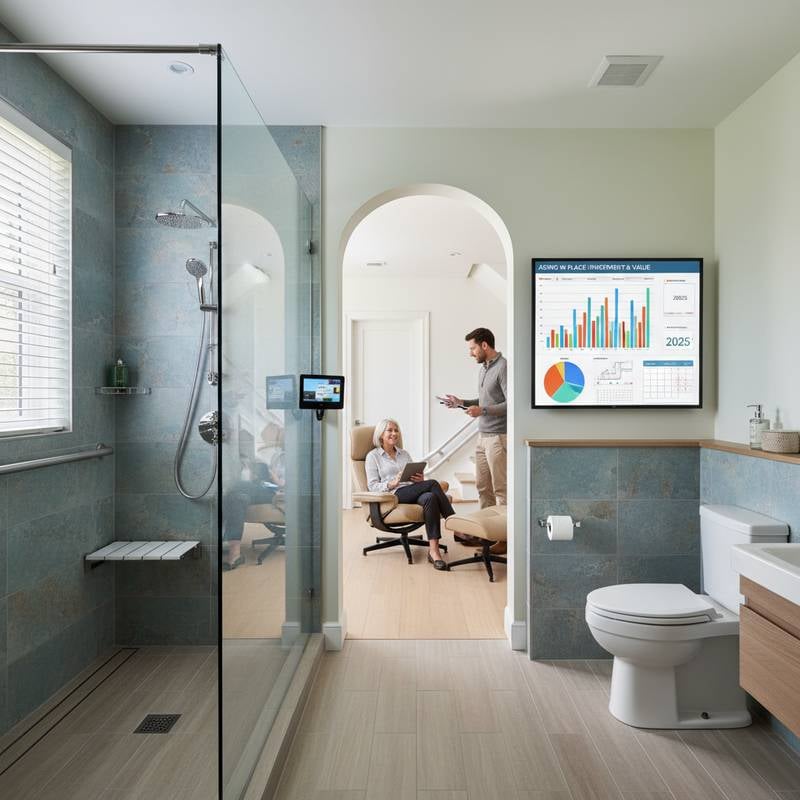Aging in Place: Costs of Universal Design Remodeling
Quick Overview
A universal design remodel enables individuals to remain in their homes safely and comfortably as mobility or accessibility needs evolve. The total cost for a comprehensive project typically ranges from 35,000 to 120,000 dollars, influenced by factors such as the home's size, existing layout, and selected materials. Targeted modifications, including grab bars or expanded doorways, generally fall between 500 and 10,000 dollars. Projects often require two to six weeks of construction time. The complexity level is moderate to advanced, with primary risks involving electrical issues, potential falls, and plumbing complications. Engage licensed professionals for any electrical, plumbing, or structural modifications.
Step-by-Step Guide to Implementation
1. Evaluate Your Home and Identify Priorities
Conduct a thorough walkthrough of each room to pinpoint mobility obstacles. Take precise measurements of doorways, hallways, and bathrooms to assess current accessibility.
- Examine areas with sharp turns or confined passages.
- Note potential tripping points, such as loose rugs or elevated thresholds.
Once complete, compile a detailed list of challenges and establish specific objectives for improvements in each area.
2. Design Safe Entry Points and Pathways
Ensure at least one entrance remains free of steps by incorporating a ramp or a gently sloped walkway.
- Adhere strictly to ramp slope standards: one inch of rise for every 12 inches of run to minimize fall risks.
Verify that all primary entryways accommodate walkers or wheelchairs without difficulty, promoting seamless indoor-outdoor transitions.
3. Install Slip-Resistant Flooring Throughout
Eliminate outdated carpeting or tiles that contribute to slips or trips by opting for durable alternatives like vinyl plank, cork underlayment, or textured ceramic tiles certified for high traction.
- Maintain level transitions between rooms to avoid abrupt changes in height.
Test the surfaces to confirm smooth navigation on foot or with mobility aids across all thresholds.
4. Expand Doorways and Hallways for Better Flow
Aim to broaden door openings to a minimum of 36 inches where feasible, which supports the passage of wheelchairs or walkers. Handle interior trim relocation or removal with precision to preserve structural integrity.
- Consult a structural engineer or licensed contractor before altering any load-bearing walls.
Confirm that mobility equipment navigates doors effortlessly, free from contact with frames or jambs.
5. Modify the Bathroom for Enhanced Accessibility
Incorporate a curbless shower featuring a fold-down bench and a handheld showerhead for ease of use. Position grab bars strategically near the toilet, shower, and tub edges.
- Secure anchors directly to wall studs or reinforced backing rather than relying on surface drywall.
Apply firm pressure to each bar to ensure it supports full body weight without shifting.
6. Optimize Lighting and Control Mechanisms
Upgrade standard toggle switches to rocker-style or motion-activated versions for simpler operation. Install layered lighting schemes that provide consistent illumination, eliminating dark shadows that could obscure hazards.
- Position light switches at 42 inches above the floor to accommodate seated users.
Assess reach and usability to guarantee comfortable access to all controls from various heights.
7. Enhance Kitchen Ergonomics
Reduce the height of select countertop sections to 34 inches to facilitate preparation while seated. Integrate pull-out cabinet organizers and front-loading dishwashers to minimize bending and stretching.
- Employ a licensed electrician for the installation of additional outlets or dedicated appliance circuits.
Evaluate storage and appliance interactions to confirm strain-free access during routine tasks.
8. Select User-Friendly Fixtures and Hardware
Swap traditional round knobs for lever-style handles on doors and faucets, which require less grip strength. Equip showers with thermostatic mixing valves to maintain safe water temperatures and prevent scalding.
- Prioritize fixtures that respond to one-handed operation.
Test each element to verify intuitive and effortless functionality.
Essential Quality Assurance and Solutions
- Irregular Floor Levels: Level the subfloor meticulously prior to laying new materials to prevent future instability.
- Insecure Grab Bars: Reinforce by tightening screws or installing extended bolts that penetrate into sturdy framing.
- Excessive Light Glare: Opt for diffused bulbs or redirect fixtures to avoid reflections on glossy surfaces.
- Restricted Door Passage: Trim the door's bottom edge minimally or realign hinges for improved clearance.
Guidance on Professional Involvement
Retain certified experts for critical tasks, including:
- Electrical system overhauls or service panel enhancements.
- Plumbing rerouting or modifications to drainage systems.
- Demolition or reinforcement of structural walls.
- Waterproofing applications for tiled areas or shower bases.
Estimated Professional Fees:
- Electrician rates: 75 to 150 dollars per hour.
- Plumber rates: 80 to 160 dollars per hour.
- Full remodel oversight by a general contractor: 50,000 to 120,000 dollars overall.
Strategies for Optimal Results
Prioritize renovations in high-traffic zones like bathrooms and kitchens to yield the most immediate benefits. Select products bearing the Americans with Disabilities Act compliance certification whenever possible to meet established standards. Maintain circulation paths at a width of at least 42 inches to support unobstructed movement. Integrate lighting and electrical planning at the outset to circumvent costly revisions during finishing stages. Allocate an additional 10 percent of the budget for unexpected contingencies, such as compliance upgrades or minor repairs.
Frequently Asked Questions
What distinguishes universal design from basic accessibility modifications?
Universal design incorporates features that benefit all users, regardless of age or ability, such as lever handles and adjustable counters. Basic modifications focus solely on immediate needs, like adding a single grab bar, whereas universal approaches future-proof the entire home.
How can one finance a universal design remodel?
Explore options including home equity loans, government grants for aging-in-place projects, or tax credits for energy-efficient upgrades. Consult a financial advisor to align costs with long-term savings on healthcare and assisted living.
Does universal design increase home resale value?
Yes, these enhancements often boost market appeal by attracting a broader buyer demographic, including multigenerational families. Appraisers recognize the added functionality, potentially increasing value by 5 to 10 percent in accessible housing markets.
How long do universal design features last?
High-quality installations, such as reinforced grab bars and slip-resistant floors, endure 20 years or more with proper maintenance. Periodic inspections ensure ongoing reliability and compliance with evolving safety codes.
Sustaining Accessibility and Independence
Universal design renovations safeguard personal autonomy while mitigating everyday risks. These thoughtful adaptations not only elevate daily comfort but also preserve property equity over time. Through diligent upkeep, quality craftsmanship, and expert consultations, homeowners secure a resilient living environment that supports vitality for decades ahead.











